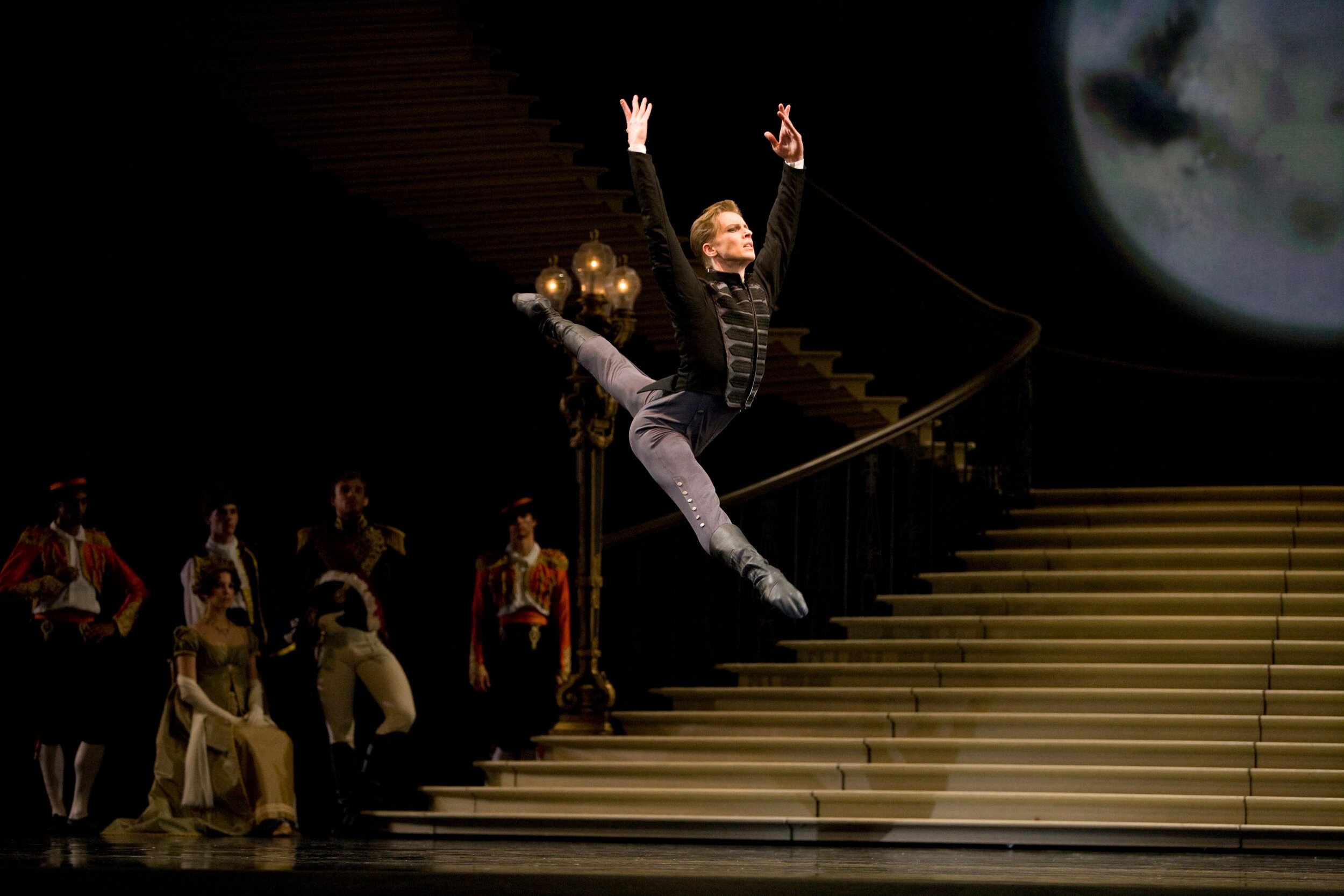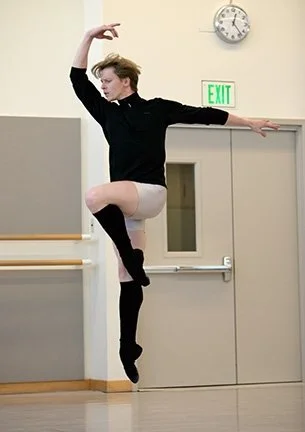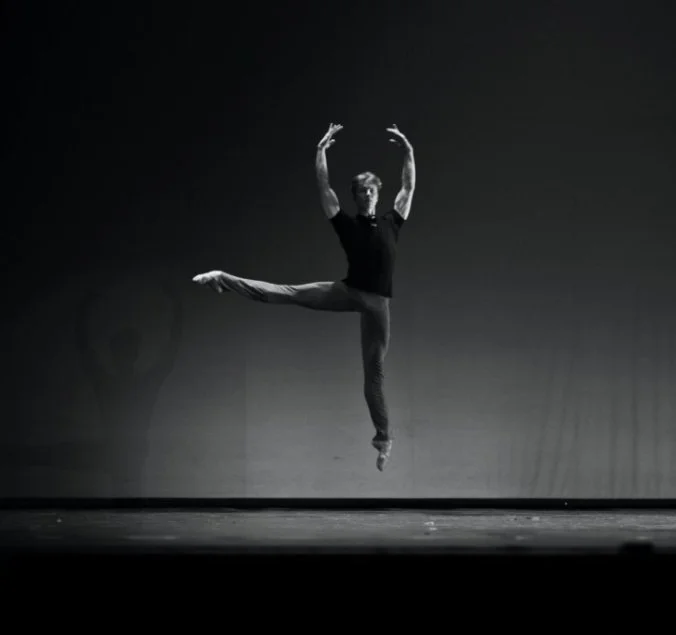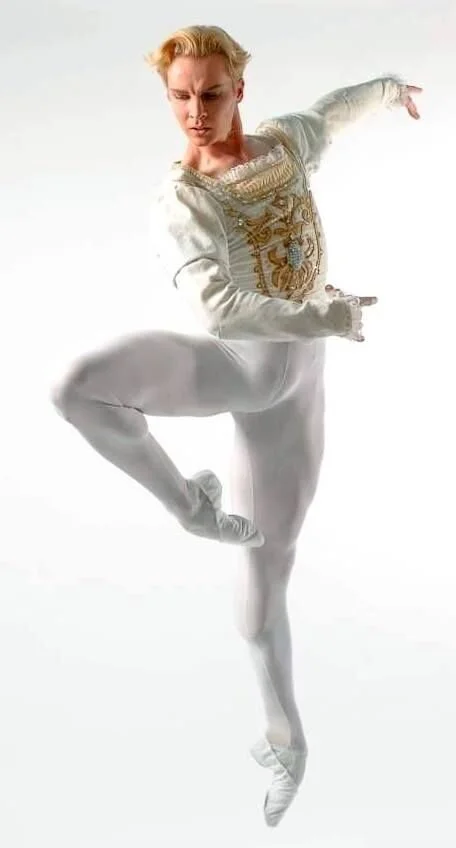Tiit Helimets - Principal (San Francisco Ballet): an Interview
Continuing a project that was started quite accidentally during this pandemic (that has given a „stop" to our cultural lives), here another interview with a very beloved and respected dancer:
Tiit Helimets, principal at the San Francisco Ballet.
Copyright: Quinn Wharton
We came in contact for the first time „some" years ago as a mutual friend, Shane Wuerthner, was also dancing with the San Franciso Ballet. Ever since then we have been many times in contact for various reasons, discussing different subjects.
But if I remember it correctly, it was back in 2017 when we started “talking” about this photo (if anyone could tell which is Mr Helimets foot… which one is Shane’s… etc.) that it all started!
Until Shane Wuerthner’s foot and Tiit’s were pictured together… Memories… Funny…
But to make a long story short, it is a MUST for me to write not only about how interesting it is to discuss and exchange ideas with Tiit, a man and an artist who knows exactly what he wants, a gifted and very intelligent man with very profound points of view about his Art but also to observe the care he takes of his family. There is lots of love involved. Beautiful.
It would not be enough to call him „a family man", it would do no justice to him, to this beautiful, singular state of mind. Sometimes, watching closely, observing what he sometimes publishes on Social media. you don't need to mention the word LOVE when you realize how he is smoothly and carefully guiding his daughter Chloe Maia in her young steps in ballet. You just feel it. Touching.
Add two more ingredients like strength and determination to all the rest above, mix it with his great talent and voilá! Yes, you are just beginning to get an idea of what Mr Helimets is „all about"
Our interview: As I have been saying for quite a while „Harsh times call for harsh methods" and this time we are not only crossing Europe and the Atlantic but also the whole North-American Continent to arrive at the West Coast – and all this by eMails, by messenger, by telephone and video conversations.
Copyright: Zaire-Kacz-Photography
Some people have asked me WHY I don't publish „Interview Videos" (they say „Everybody is doing them now!"). Well, to be quite honest, it is NOT my style. I do believe that an interview made just by video will lose its interest after a short while. Using the written word is a way of saving all this precious information for future generations, for the ones who research and read more but also it is – I must confess – much more effective to give some „rhythm" on paper than altering and cutting a video interview. And to be quite honest with you: I never do things just because „Everybody is doing them now"... Let them.
Working this (you may call) „old-fashioned" way is much more attractive to my way of thinking or as the old Juliette Greco hit goes:
„Je suis comme je suis
Je suis faite comme ça"
Copyright: Eik Tomasson
„Dear Tiit, before we start, please just a few words about Estonia and your beginnings as a student of dance.. „
„Yes, I grew up in Estonia. I was born in a little town called Viljandi, but I lived in a village called Halliste.
I started taking classes at the age of 10 in the Estonian National Ballet School. My mom took me to the audition. She saw that I had a big imagination and I loved to dance."
„And when did you begin to dance professionally?"
„ I started my professional career after graduating from the ballet school in 1996 when I joined The Estonian National Ballet company as a soloist. After six months I got promoted to Principal and made Estonian history as the youngest ever to dance the role of the prince Sigfried in the Swan Lake"
„But you also worked in England before starting with The San Francisco Ballet, right?"
„Right", After three years with The Estonian National Ballet, I joined the Birmingham Royal Ballet as a soloist, where after two years I was promoted to Principal dancer. I danced in England for six years, before joining The San Francisco Ballet as a Principal Dancer."
„And why exactly the States?"
„Two reasons, one is that my wife is from the States (note: Molly Smollen has resumed her career and works nowadays as an attorney assistant) and she wanted to be back in her home country and the second is that San Francisco Ballet was a company where constant growth in ballet was happening and I felt like I was missing the big boat that moved the art form forward."
„You and Molly have danced together..."
„We danced many times together, also with the SFB"
Coyright: Erik Tomasson
„You said that you have started your career as a soloist – did I get this right? Quite unusual nowadays... and a proof of great talent..."
„You got it right; I started as a Soloist" he answers, nearly humbly.
„How was it to adapt to this more „western" style of dancing – pardon me the expression – after so many years growing up as a dancer in the „East", perfecting your technique at the then so-called “East Block”?"
„After I left Estonia it was quite hard to adjust to different styles. In England, it was somehow easier, because most of the new repertoire was neoclassical but coming to SFB changed this. It was truly a very hard (long) period adjustment. Doing Helgi's (Note: Helgi Tómasson) „Sleeping Beauty" alongside Mc Gregor's choreography was a massive „body shock". This was unfortunately the beginning of regular minor injury cycles. I think that after five years in the SFB, I first noticed that I was dancing, for the most time, always injured"
„Do you miss any particular parts at the present moment?"
He thinks for a short time and answers quite pin pointedly „I miss dancing Ashton and MacMillan. I like short ballets with a story and I am sure so does the majority of the audience. But that being said, I must say that have done and created so many amazing ballets here in SFB... „
„Are you more into „story-telling ballets" or more abstract ones, Tiit? And how is your working process as to developing a character and/or a certain part?"
„I like parts with a story. When I create a character I allow the choreography to be laid out first to learn it properly. Then, based on that I create a character on top of it. That is the best part of creating works, especially when one gets to collaborate with the choreographer"
„Any role especially that, for any kind of reason, you are somehow strongly connected to or even perhaps displeases with your performance/interpretation of it?"
„Basilio, definitely... (Note: „Don Q."). I was „thrown" into this role at the last minute and the process was fast. I was given too much freedom to do what I wanted with this character and, let's admit it, I thought I needed very minimal guidance. On top of that, I made the mistake of packing my character up with too much technical bravura and in the end, the result was extremely generic. I ended up being just like what I had seen in other interpretations: lots of technique and no character development. I am glad I danced this role, but I am happy to never have to dance it again.
„But perhaps with the right coaching?" I ask.
Knowing exactly what he wants, he says calmly „I don't think that other kinds of coaching would have helped. I just did not like Basilio's as a character. The only characters I find interesting in that ballet are Don Quixote and Sancho Pancho"
„Which character/part do you consider as the biggest challenge in your career until today?"
„I still find the second movement of "In The Night" character hard and I have tried so many times and it never looks right to me. The prince in The Little Mermaid was very hard to decipher. I strongly disliked (could not relate to) my character Edward the prince. That made it very difficult to portray him."
„In the work of which choreographer do you feel more "at home"?"
„Val Caniparoli, Wane Mac Gregor, Helgi Tomasson, Yuri Possokhov, Julia Adam, Alonzo King, Edward Liang, Cathy Marston, George Balanchine and anything classical (Petipa, Ashton, McMillan, Lifar)"
„Are there any parts which you "love" but haven't danced yet? If you wish to dance them... tell me why?"
„I think that there are many roles I could have done, but nothing significant comes to my mind right now."
Copyright: Erik Tomasson
„Concerning the "younger generation": how do you see the problem of lack of information? To explain what I mean: younger dancers learn a huge repertoire and dance much more than other generations before them BUT they don't read, they don't go to museums, they do not enjoy or appreciate other art forms... even with the possibilities of the internet (and mobiles) they don't get enough information and just seem to watch videos... what is your opinion?"
„I believe in the younger generation. I have yet to meet those individuals you mentioned. All I see is curious young dancers working extremely hard every day. Because nowadays Google is handy, these young individuals are a big source of information and knowledge. I am curious to learn from the younger generation and educate myself. Also, I am willing to share all of my life experiences with them if they are willing to listen but I don't want to impose."
„That is very good and quite positive to listen – tell me please HOW do you prepare for a new role – I am not talking about abstract parts! Just tell us wor is your creative process is... think of a classical character; perhaps the last one you created „from scratch"... „
„After I have learned all the dancing steps, I start to focus on intention. My big help is the "Why". Why do I do this gesture, can I incorporate it into my solos, can it become a theme for my character. Recently I had a chance to create a brand new character in the Wooden Dimes for our digital season (I believe it has just finished its run yesterday). This character is a Director. He sees people as objects to make himself more successful. His interactions with people are all self-serving. The way that he touches people is like picking off cat hair from his suit. He is happy and excited in that scene because this individual that he is grooming up to be a success will make him lots of money, but he does not care about her at all. I have met people like this in my life, so finding inspiration was easy, but this role by no means is easy to portray."
„What is being lost nowadays in terms of "style"?"
„I don't think anything is lost. Ballet is ballet. Having style or not, personally to me, has nothing to do with being good or bad. If the individual is open to adapting to different styles that is the kind of dancer who everyone wants to work with."
On the other hand, having too much-affected style can work against the individual.
I feel that adaptability and versatility is the key."
„I don't think that I have expressed myself very well... let me give you an example: The last time I have watched „La fille mal gardée" (a ballet that I honestly am not very fond of, I must say) at the Vienna Opera I was quite surprised by the lack of style... „Style" can be neither repeated automatically nor copied. It has to be refreshed all over again and, most of all, understood! I do not know who did the coaching but what was going on stage had absolutely nothing to do with Ashton. I even felt like contacting the „Frederick Ashton Foundation"..."
„I can relate to the lack of coaching issues. This I believe has nothing to do with dancers. Dancers always want to present themselves the best way they can. If the style was emphasized in rehearsals the dancers would do it. I am sorry that you had a bad experience watching this ballet. I have danced Colas many times, but it was not an easy character for me to dance and portray."
Copyright: Maria Helena Buckley
„How do you see the ever-growing problem that there seems to be far too much concern about technique? Yes, EVERYBODY has to turn so and so many pirouettes, have elevations never seen before, etc. etc... Doesn't it seem that so much (I think of Marcia Haydée, Plissetskya, Makarova, Bruhn and many others) is being lost in terms of ART?"
„I think it is wonderful that dancers are pushing the boundaries of technique, but the individual's artistry comes from the director of the company. If the director demands that the dancers go beyond the steps, focus on the characterization, then the art will continue to evolve and offer new opportunities to the young and up and coming dancers to be artists on the stage."
"I am not sure that I can share this opinion – for me, first of all, you are ARTISTS (not technicians) and to (also) focus on the character, the "whys", "because", "dos and don'ts" of it should be, to my way of thinking, more than a natural, visceral, instinctive part of the work... There should be no need for a director to explain this... don't you agree?"
„You would think that this was the case, but it is not. I see too many times dancers going out on the stage and only knowing 25% of the character that they are portraying on the stage. I have inquired them about what you are saying here or what is their intention and they shrug their shoulders and say I have no idea why.
I was fortunate to work with a director who insisted that attention to character is 50% of your show and the other 50% is technical. My biggest frustration with directors not emphasizing to go beyond the steps is why we see an excellent technique on stage with mediocre acting that leaves the audience cold. So I would disagree with you here. I feel that the directors must emphasize the importance of acting/intention/reason, but on the flip side to many artistic leaders acting is not important and that is also fine. I believe in a whole artist who is versatile as an actor and dancer. This is something that can be taught, but not emphasizing its importance is a wasted opportunity for growth in this art form."
„Tiit" I add relaxedly „I do believe that we are not disagreeing, on the contrary, we see things the same way, the only difference is that I „expect" this to come „naturally" from the dancers and as you (once more... unfortunately this is not the first time that I've heard this statement!) confirm to me – the director must make people aware of it... Sad... Well, dear, what about one last word for our readers today?"
„No last words. Thank you for wanting to hear my opinions, story, points of view!"
Copyright: Quinn Wharton
But somehow it did not feel „right" to stop right there... I thought for some time and came to the conclusion that, yes, there was still a question to be made...
„I have been thinking for a while and I still do have a "last question". You see, I need somehow to make this interview „round" (I like to describe things I enjoy as "round". It is my favourite form to represent something pleasant, comfortable... ) and there is still a point I would touch with you... Here it goes: Dear, you are a European through and through – this is so obvious to me while watching you dance, feeling your ways and thoughts and ideas through your movements. Even if you have been living for about 2 decades in the U.S.A., you are still a European... the approach to dance is very different here when compared to Europe. The South-American way (Doesn't this sound like an old Carmen Miranda Musical from the 1940s at 20th Century Fox?), even if at the moment not very representative worldwide, is quite similar to the one in the States - I do not say "to the North-American" because I consider the Canadians much nearer to the Europeans then Americans... I see in the States (now) an even stronger "cult to physicality" than some years ago- how do YOU see to that? "
„I hope I am understanding this question correctly, Ricardo. One major thing that has always appealed to me about the United States is that people speak their mind here. That takes me to the next thing and that is that the American dancers have a kind of inherent freedom that comes through their dance that is unique to this country. This freedom of expression is something that has brought me here. I admire the way the dancers, in this company, dance like there is no obstacle in their way and the future is bright. These American dancers, thankfully, have never experienced oppression, lack of basic resources (food, electricity, hot water) and war in this country. They have had a lifestyle (probably not all) that has allowed them to grow up to be confident, forward-thinking expressive dancers. I never had that and I love seeing that positive spirit shines through them when they dance. I love the style of dancing in American dancers and I believe that when they dance European dance works they add a new layer to those works that make those works fresh again"
„No... you haven't actually understood what I meant - my fault, I fear – I must admit that I have phrased the question terribly...) but, you know what? I AM VERY GLAD that you did not.
Your answer is the perfect "ending" for our interview... it reveals so much. It gives so much. Great stuff; so much honesty! Boy, am I glad! That made my day!
Thank YOU very much for sharing your thoughts with us! It was really nice to spend this time with you!
And I have to add that it has been fun working with you, penetrating your mind!"













